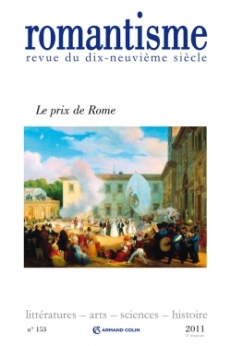
Romantisme n° 153 (3/2011)
Pour acheter ce numéro, contactez-nous
Recevez les numéros de l'année en cours et accédez à l'intégralité des articles en ligne.
L’édition des procès-verbaux de l’Académie des beaux-arts actuellement en chantier à l’École nationale des chartes concerne pour l’instant la période 1811-1871. L’ampleur du travail d’ecdotique qu’elle impose conduit à s’interroger sur la rentabilité scientifique d’un tel effort. Pour les uns, l’Académie n’aborde rien d’intéressant au cours de ses séances ; pour d’autres, le plus substantiel en a déjà été exploité ; pour d’autres enfin, l’essentiel, le jugement des envois des pensionnaires romains, justifierait d’un traitement à part. Il est clair, néanmoins, que ces contestations ne tiennent pas : les procès-verbaux constituent une source considérable pour l’histoire de l’art du XIXe siècle. En particulier, pour l’histoire du grand prix de Rome. D’année en année, ils relatent avec minutie le déroulement d’une procédure complexe, donnent le nom de tous les compétiteurs, laissent entrevoir parfois les enjeux qui mobilisent les jurés, y compris les projets de carrière personnelle. Accompagnée de tables et d’index commodes et nombreux, l’édition des procès-verbaux offre un incontournable point de vue.
The edition of the minutes of the Academy of Fine Arts now in progress at the École nationale des chartes is concerned at the present time with the period from 1811 to 1871. The amount of “ecdotic” work required for this task leads one to wonder about the scientific viability of such a project. For some, the meetings of the Academy are of little interest; for others, the most important aspects of the meetings has already been explored; and for still others, the essential element, the judgment of the materials sent back to Paris by the pensionnaires in Rome, ought to be the subject of a separate inquiry. It is nonetheless clear, these arguments notwithstanding, the minutes comprise a source of considerable importance for the history of nineteenth-century art, and, in particular, for the history of the Prix de Rome. From year to year, they relate in detail the carrying out of a highly complex procedure, they give the names of all the contestants, the give clues about the issues the motivated the various jurors, including matters of concern to their own careers. Accompanied by tables and multiple indexes, the edition of the minutes provides a point of view that cannot be ignored.

